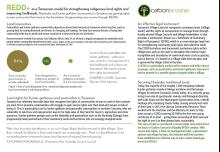Land Library
Bienvenue dans la bibliothèque du Land Portal. Explorez notre vaste collection de ressources en libre accès (plus de 74 000), comprenant des rapports, des articles scientifiques, des articles de recherche, des publications évaluées par des pairs, des documents juridiques, des vidéos et bien plus encore.
/ library resources
Showing items 1 through 9 of 27.This report consolidates findings from previous activities by FAO and other stakeholders, and identifies in the four focus countries (Ethiopia, 
Until recently, the Pokot in the highlands of the Baringo area in Kenya have practised semi-nomadic pastoralism. Today they are rapidly sedentarizing and in many areas suitable for farming, they are adopting rain-fed agriculture.
Pastoralists are one of the most poverty stricken and underdeveloped existing human groups in the world. Until now, having remained practically invisible in the eyes of international law, it is desirable to open a debate concerning the recognition of their rights.
This article addresses political rights and identity among Il Chamus of Baringo District, Kenya, a small group of agro-pastoralists related to the Maasai.
The technical guide on improving the governance of pastoral lands is designed for several audiences including government and non-government actors.
The goal of the Rangelands Initiative is increased tenure security of local rangeland users through improved implementation of enabling policy and legislation.
As part of the Global Call to Action in Indigenous and Community Land Rights, this brief puts the spotlight on the need to secure land rights for the world's pastoralists, as pastoralism is practised by an estimated 200-500 million people. Pastoralists manage rangelands that cover a quarter
Pastoralist and hunter-gatherer communities in Tanzania are gaining rights to own and control their land as the foundation for generating new income through REDD+
Pastoralists have a unique relationship of mutual dependency with their livestock and their environment; the uniqueness of this relationship distinguishes them from other livestock keepers.









